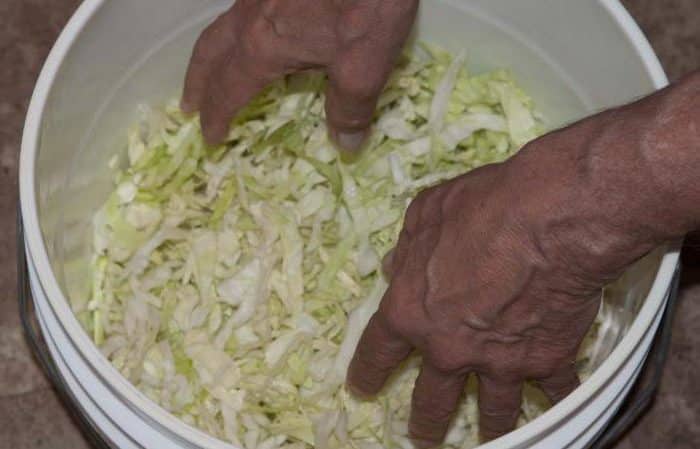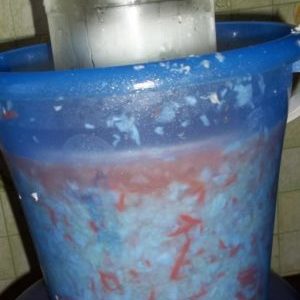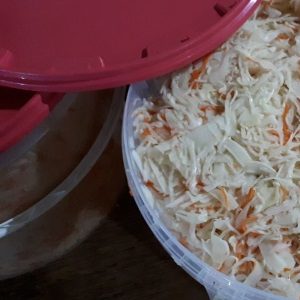Is it possible to ferment and salt cabbage in a plastic food bucket and other plastic containers?
The favorable period for pickling cabbage is autumn and early winter. By this time, the vegetable is fully ripe and ready for further cooking. Before you start fermenting, you need to prepare the cabbage, container and additional ingredients. The main problem arises when choosing a container. Not everyone knows that you can pickle vegetables not only in glass jars, but also in a plastic bucket. You will learn how to prepare sauerkraut for the winter in a bucket from this article.
Is it possible to ferment cabbage in a plastic food bucket?
You cannot find a more suitable container for pickling than a wooden barrel. But for such a container it is almost impossible to find a place in the apartment, and it turns out to be too much cabbage. Therefore, an enamel pan is most often used for fermentation, but without chips or other external damage. Otherwise, the quality of the vegetable will deteriorate.
Reference. You cannot salt in containers made of non-enamelled metal, aluminum or other steel. During fermentation, the acid reacts with the metal, and the vegetable loses its taste and beneficial properties.
Most summer residents are concerned about the question of whether it is possible to salt cabbage in a plastic barrel. After all, during salting, acid is formed, which begins to interact with the plastic. The vegetable absorbs odors and various harmful impurities and chemicals. Using low-quality containers can cause harm to health. That's why:
- Buy colorless containers, do not use brightly colored plastic.
- Buy quality buckets. Be sure to ask the seller for a certificate to ensure the quality of your purchase.
- Before pickling vegetables, wrap the inside of the bucket with a plastic food bag or cling film.
- Wash the new container several times. Then fill the bucket to the top with water and leave it for 24 hours. Then dry in the open air.
- Sauerkraut until fully cooked. Next, transfer to a glass jar, compact and fill with your own juice.
The best option for fermentation is considered to be dishes made of food-grade plastic. It should have a sign in the form of a triangle with the numbers 5 or 05.
All other containers are not suitable for processing and storing raw materials - you can get poisoned.

Read also:
In other plastic containers
It is allowed to use containers, barrels or basins made of food-grade plastic. The quality of the cabbage and the fermentation period will depend on this. Plastic containers are rarely made from a material that can come into contact with food. It is better to use glass and ceramics.
High-quality plastic has the following advantages:
- tolerates temperature changes;
- easy to clean;
- suitable for reusable use;
- seals hermetically;
- easy to operate.
The best recipe for sauerkraut in a plastic barrel

The most suitable cabbage varieties are mid-late. They contain sugar necessary for fermentation. Summer residents recommend using heads of cabbage that have been caught by a little frost. But you should avoid frozen vegetables. The forks should be large, without cracks, mold or damage.
Various additional ingredients are added to sauerkraut for taste: bay leaf, plum, pumpkin, apples, horseradish, currants, pepper and oak bark.
Main cast:
- 10 kg cabbage;
- 200 g coarse table salt;
- 200 g carrots.
Preparation:
- The head of cabbage is cut in half and chopped or cut into squares.
- The carrots are chopped into strips or slices.

- Combine vegetables with spices, mix thoroughly and mash with your hands until juice appears.
- The bottom of the container is covered with cabbage leaves, the mixture is poured in and compacted until the juice is released.
- Cover with a cloth, a lid that is smaller than the diameter of the barrel neck, and place under pressure (a stone, a weight or a container of water).
- Leave to ferment at room temperature, piercing the cabbage daily to the bottom with a wooden stick and skimming off the foam.
- In 3-5 days the dish will be ready. It is sent for storage in the refrigerator.
How to pickle in a plastic bucket for the winter: recommendations

To reduce the contact of salted vegetables with plastic, cover the container with cling film.
You can put the vegetables in plastic bags in advance, and then put them in a plastic bag. bucket. It is used only for the salting process.
Cabbage cannot be stored in such containers - it is transferred to 3-liter glass jars.
Ferment the vegetable at room temperature. When the foam stops being released, the brining process is considered complete. Then the product is put into the refrigerator, cellar or balcony, where the temperature does not exceed 0°C.
Read also:
Conclusion
For sauerkraut, use food-grade plastic containers marked 5 and 05 or wrap the inside with cling film.This will prevent the product from reacting with the plastic. Store the product only in glass jars so that the beneficial properties of cabbage are not lost.
Thank you for the article!